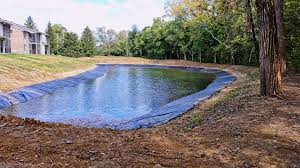Creating a backyard pond is an exciting way to enhance your outdoor space, providing a peaceful retreat and a habitat for wildlife. At the heart of any successful pond is the pond liner, a crucial component that ensures your water feature remains leak-free and lasts for years to come. In this guide, we’ll explore the importance of choosing the right pond liner, its various types, and essential tips for installation and maintenance.
What Is a Pond Liner?
A pond liner is a flexible or rigid material used to line the bottom and sides of a pond. Its primary purpose is to hold water while preventing it from seeping into the ground. Whether you’re designing a small koi pond or a large water garden, selecting the appropriate pond liner is key to achieving durability and efficiency.
Benefits of Using a Pond Liner
- Prevents Water Loss: A pond liner acts as a barrier, ensuring water remains in the pond without leaking into the soil.
- Design Flexibility: With a flexible pond liner, you can create ponds of any shape and size.
- Protects Against Erosion: A pond liner helps stabilize the soil, preventing erosion and maintaining the pond’s structure.
- Supports Aquatic Life: A high-quality pond liner creates a safe and stable environment for fish, plants, and other aquatic life.
Types of Pond Liners
When selecting a pond liner, it’s important to consider the material, durability, and suitability for your specific needs. Here are the most common types:
-
Rubber Liners:
- Flexible and durable, rubber liners such as EPDM are a popular choice for backyard ponds.
- They are resistant to UV rays and weathering, making them ideal for outdoor use.
-
PVC Liners:
- PVC liners are lightweight and affordable, making them suitable for smaller ponds.
- They are easy to install but may require additional protection against punctures.
-
Preformed Liners:
- Rigid and durable, preformed liners are made from molded plastic or fiberglass.
- They are best for those who prefer a fixed pond shape.
-
Geotextile Liners:
- These liners are made from synthetic materials that provide added strength and resistance to tearing.
- Often used in larger or commercial ponds.
How to Choose the Right Pond Liner
-
Consider the Pond Size:
Measure the length, width, and depth of your pond to determine the required liner size. -
Evaluate Durability:
Choose a liner that can withstand your local climate, UV exposure, and the weight of the water. -
Assess Flexibility:
If you want a custom pond shape, opt for a flexible pond liner like rubber or PVC. -
Budget Planning:
Select a pond liner that fits within your budget while meeting quality standards.
Installation Tips for a Pond Liner
-
Prepare the Site:
Clear the pond area of debris, rocks, and sharp objects that could puncture the pond liner. -
Add Underlayment:
Use an underlayment fabric to protect the liner from damage caused by roots or rocks. -
Position the Liner:
Gently lay the pond liner over the prepared site, ensuring it covers all edges and corners. -
Secure the Edges:
Anchor the liner with rocks, soil, or other materials to hold it firmly in place. -
Fill the Pond:
Slowly add water, smoothing out any wrinkles in the liner as it fills.
-
Regular Cleaning:
Remove debris and algae buildup to prevent damage to the liner. -
Monitor for Leaks:
Periodically inspect the liner for signs of wear, punctures, or leaks. -
Protect from UV Exposure:
Use pond plants or a thin layer of gravel to shield the liner from direct sunlight. -
Seasonal Care:
During colder months, ensure the pond liner remains free of ice damage by maintaining water movement.
Enhancing Your Pond’s Longevity
A well-chosen and properly installed pond liner can provide years of enjoyment. Whether you’re building a small garden pond or a large aquatic feature, investing in a quality pond liner ensures the durability and beauty of your backyard oasis. With regular maintenance and care, your pond can remain a focal point of relaxation and natural beauty for years to come.


